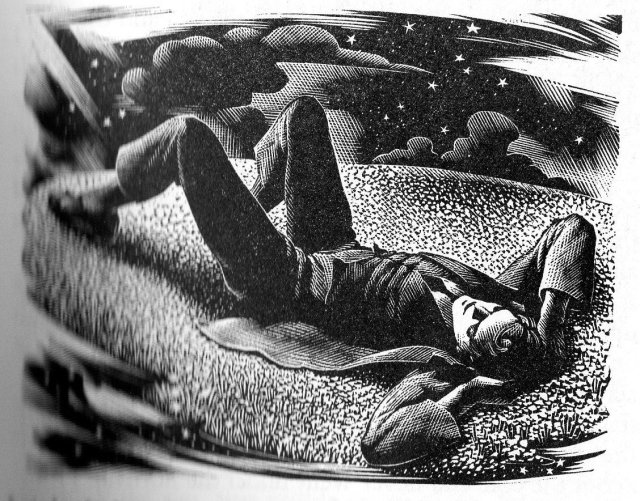Rebecca Welshman
Two books that have made a lasting impression on me are James Redfield’s The Celestine Prophecy, and Richard Jefferies’ The Story of My Heart. I read Redfield in 1995 and didn’t discover Jefferies until 2003.
When it was published in 1993, The Celestine Prophecy quickly established a following and was known to change the lives of its readers. When I read it, aged fifteen, it made sense to me – particularly the idea that we lived in a material world made of energies that was closely aligned with a spiritual dimension also made of energies. A poignant section of the book is summarised here:
“The book suggests that the world is undergoing an enormous shift in consciousness, elaborating on how things had been generally understood until now: 1) at first people believed the world to be governed by the forces of divinity; everything could be explained as an act of a god or gods, 2) with increased knowledge of their world brought about through scientific inquiry, people turned to the men and women of science for an explanation of life and their world, and 3) without a satisfactory answer from science, people instead had them focus on efforts to improve their lives materially and subdue the earth, illustrated by a hyper-focus on economic conditions and fluctuations. What was now occurring was that the baseness of current conditions was revealing itself in our souls. We had become restless and were now ready for another fundamental shift in thinking that would eventually bring about a better world.” (https://en.wikipedia.org/wiki/The_Celestine_Prophecy)
This situation of spiritual crisis is not radically different to what Jefferies proposed in The Story of My Heart. Realising that the soul could not breathe through the crust of civilisation in which it was set, he sought to break through and seek out a new circle of ideas outside of divinity, science, and material reality. Writing about his book, Jefferies explains:
“He claims to have erased from his mind the traditions and learning of the past ages, and to stand face to face with nature and with the unknown. The general aim of the work is to free thought from every trammel, with the view of its entering upon another and larger series of ideas than those which have occupied the brain of man so many centuries. He believes that there is a whole world of ideas outside and beyond those which now exercise us.”
Redfield’s book, written in the form of a story, explores how to recognise and engage with the spiritual dimensions of our ordinary lives. Our thoughts and actions are motivated and directed by our engagement with energy – we need to learn how to ‘see’ this process and develop our conscious awareness. We can do this through focusing on the beauty and energy of natural things which raises our own positive energies. Many spiritual traditions recognise that the soul or spirit of a person does not need the body to exist. The Celestine Prophecy explores how it is possible for the spirit to consciously travel outside of the body – a version of what is known as astral travel.
Many of us may be familiar with the passages in Jefferies’ works which describe him lying down on the ground and looking up at the stars. These occur in Bevis, The Old House at Coate, and are alluded to in The Story of My Heart. When he writes that he feels ‘among’ the stars, he seems to be close to a state of astral travel – almost willing his spirit to leave his body and travel freely:
“Seeing the sun thus day by day traverse the sky about the house, passing the fixed points corresponding to the compass, and changing her position with the seasons – so that the house, the garden, and the trees about it made one large sidereal dial – made the solar apparent motion and the phenomena of the heavens very real and almost tangible. …
Here was the centre of the world, the sun swung round us; we rode at night straight away into the space of the stars. On a dry summer night, when there was no dew, I used to lie down on my back at full length (looking to the east), on the grass footpath by the orchard, and gaze up into the sky. This is the only way to get at it and feel the stars: while you stand upright, the eye, and through the eye, the mind, is biased by the usual aspect of things: the house there, the trees yonder; it is difficult to forget the mere appearance of rising and setting. Looking straight up like this, from the path to the stars, it was clear and evident that I was really riding among them; they were not above, nor all round, but I was in the midst of them. There was no underneath, no above: everything was on a level with me; the sense of measurement and distance disappeared. As one walks in a wood, with trees all about, so then by day (when the light only hid them) I walked amongst the stars. I had not got then to leave this world to enter space: I was already there. The vision is indeed contracted, nor can we lift our feet further than the earth; yet we are really among these things to-day.” ‘The Seasons and the Stars’, in ‘The Old House at Coate’

The life of the soul follows no well-trodden paths, adheres to no fixed points of a compass, and carves its own unique journey. Jefferies grew to realise this, and part of this realisation involved changing his value system. By the time he wrote The Story of My Heart he had already let go of the trappings of society and considered the life of the soul the only future worth working for:
“Let the floor of the room be bare, let the furniture be a plank table, the bed a mere pallet. Let the house be plain and simple, but in the midst of air and light. These are enough a cave would be enough; in a warmer climate the open air would suffice. Let me be furnished in myself with health, safety, strength, the perfection of physical existence; let my mind be furnished with highest thoughts of soul-life. Let me be in myself myself fully. The pageantry of power, the still more foolish pageantry of wealth, the senseless precedence of place; I fail words to express my utter contempt for such pleasure or such ambitions.”
In his own words he describes the ambitions of the book:
“From all nature from the universe he desires to take its energy, grandeur, and beauty. He looks forward to the possibility of ideal man, and adduces reasons for the possibility of such ideal man living in enjoyment of his faculties for a great length of time. He is anxious that the culture of the soul should be earnestly carried out, as earnestly as the culture of the body was in ancient Greece, as that of the mind is at the present day. So highly does he place the soul, that if it can but retain its consciousness and attain its desires he thinks it matters not if the entire material world disappears. Yet the work teems with admiration of material beauty.”
Here Jefferies seems to be preparing us for a future without the material world. The idea of the material world not being necessary for the soul to exist is something that Redfield addresses in the volume that came after The Celestine Prophecy titled ‘The Tenth Insight’. In this book he writes about the higher perspective of the Afterlife, which can be reached by progressively working on our positive vibrations. What struck me about Redfield’s book was its dedication to advancing the life of the soul – something that Jefferies earnestly wished for, and refers to above as the ‘culture of the soul’.
It doesn’t really matter what critics have said about Redfield’s book because it is a work of light. The darkness of our own fears, doubts, and unresolved emotions holds us back, but these are realities which we ourselves are responsible for enforcing – no one else. Redfield and Jeferries both highlight the value of natural beauty as an energy source that can replenish us. Both recognise the concept of an Eternal Now with its potential to help us see beyond the limits of our historical and cultural circumstances, and even beyond the limits of consciousness itself. Like Redfield, Jefferies was a light-worker, and he believed that if the work of the soul could be developed, then it would be enough to lift us from the veils and webs that seemed determined to restrain us. Jefferies may only have got so far with his work, and he had much more to give, but such work can and should continue for the sake of our spiritual future.


As a big fan of Jefferies’ writing and ideas, I recently read ‘Story of My Heart’ with great interest – the ideas he covers here have run through other books of his I’ve read. I suppose any fan of Jefferies work would recognise much of the feelings and desire he describes, though probably not to the same extent or obsession. I also have spent a great deal of thought in tackling such notions; attempting to achieve or explain something of them. Here is a – slightly tongue in cheek – video I made two years ago, to present my findings:
LikeLiked by 1 person
Enjoyed your video, thank you for sharing it.
LikeLike
Beautifully written and deeply felt. My spirits are buoyed by reading this piece. Thank you.
LikeLiked by 1 person
It’s lovely to hear that, and thank you for leaving a comment.
LikeLike
I read ‘The Story of My Heart’ for the first time at Easter 1953. It had the effect of summing up everything I’d thought about ‘life’ till then – I was 16. I have to say that it was a book that changed my life. I re-read it frequently. I’ve even laid flat out on Liddington Hill and read bits of it. Thanks for the reminder!
LikeLike